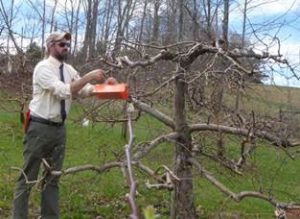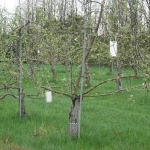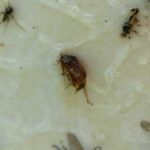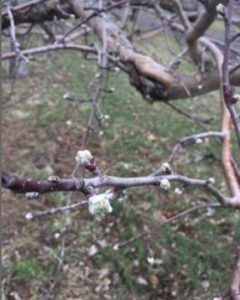By Terence Bradshaw
April 5, 2017
NEWA Apple Scab and Phenology Models
We don’t need computers and models to tell us that by mid-April we ought to expect apple bud break to be around the corner, and with temperatures in the 70s forecast for Monday and Tuesday of next week, I expect many orchards to be at green tip by then. Of course this does have us looking to apple scab development models to get a sense of where we’ll be on that front next week, and more than one grower noticed in the past day or two that there is an anomaly in the NEWA apple scab model for many sites. There are two models on the scab page, one which is predicting your bud stage, and the other which predicts apple scab ascospore maturity. The latter model relies on McIntosh green tip as the biofix to start accumulating degree days, so if the model guesses wrong, then your accumulation may be incorrect.
However, remember that these are simplified models that are predicting complex biological phenomena. The development of apple tree phenology is dependent on more than just air temperature, and of course there are multiple methods of measuring degree days to further complicate things. So the model that guesses the green tip and other phenology stages for your site may not be correct, and you should always enter site-specific data for your orchard to increase the accuracy of the model. On the other hand, the predictive phenology model built into the apple scab model is a bit more conservative than the previously mentioned and more visible phenology model that populates the ‘green tip date’ box on the site. During a conference call yesterday with NEWA state coordinators and overall program coordinator Dan Olmstead and former coordinator/NEWA developer Julie Carroll, we learned that they intentionally set the ‘green tip predictor’ in the scab model a bit more conservative so as to not miss early ascospore development. The result is that the apple scab model can show accumulated degree days since green tip while the green tip predictor model says you are still xx days away from green tip.
The moral of the story is twofold. First, for any NEWA model that calls for a biofix you will get more accurate results if you enter an actual value for your orchard. Second, remember that these are models and therefore are well-educated guesses, and thus you should not assume 100% confirmation to actual biology in the orchard. They are good, and have become invaluable to all of our work, but sometimes common orchard sense (e.g., there’s no green tissue so there’s no scab risk to worry about) is still important.
What About the First Scab Sprays?
I’ll go out on a limb and say that in the major apple production areas we will have green tip next week. However, the long-term weather looks relatively mild, warm but not outrageous, so I expect bud phenology and ascospore development to move along at a moderate pace. If your orchard was clean last year, and I mean you know it was clean by assessing lesions in the fall using a PAD method, then you can likely skip the first scab spray, depending on when that is needed. Of course we need rain and extended leaf wetness to initiate an infection, so if it’s dry, you don’t need protection. After the next couple of days where the prognosticator in me says with 100% certainty that it will be rainy (but without green tissue on trees to be infected), I don’t know what the rain situation will be like next week.
However, we will be advancing from green tip toward 1/2” green, and that is the last window to apply copper which will be extremely important to do on any orchard that had fire blight last year. That copper spray will also give you 5-7 days’ protection against scab, so consider that your first spray against both of those diseases. Copper’s effect on fire blight is to reduce overwintering inoculum on wood, this assumes that you were thorough in pruning out infected wood, especially those big cankers that can form on limbs and trunks. After 1/2” green tip, you run the risk of causing fruit russet with copper application which can severely downgrade fruit marketability. If you are growing fruit for sale to cideries and know for certain that you will not be marketing for fresh fruit, you may be able to extend your copper spray window a bit, or consider using low rates of copper later in the growing season for management of apple scab or fire blight. However, there are generally better alternative products to use later in the season if you plan ahead, unless you are limited to organically-acceptable materials.
I would plan on applying copper to any orchard that had any amount of fire blight last year and which is showing green tissue or at least solid silver tip as soon as you have a suitable spray window. If possible, I would plan on applying copper to any orchard, period, that is between silver tip and half-inch green in the next 7-10 days. There is a pile of materials out there and for all intents and purposes for this delayed dormant spray any of them are effective as long as you are applying a good full rate of copper ions. The standard dry materials like Champ, C-O-C-S, Cuprofix, Kocide, etc. will give you the best bang for the buck here, and I would apply the full label rate for any of them and thoroughly spray the whole orchard. The only caveat I offer is if phenology advances rapidly before you can get out there and the trees are at 1/2” green tip, in that case, I would apply a low to middle rate. After 1/2” green tip, unless you don’t care about fruit finish, I would avoid copper.
Cleaning Up
The next week looks good for performing orchard sanitation to get things ready for spring- wrap up your pruning, push any brush out of the rows, flail mow leaves and fine brush, and consider applying a coarse urea spray (44 lb in 100 gal water applied per acre, directed at the leaf litter). The latter two practices can reduce overwintering scab inoculum and allow you, if you had low incidence of scab last year and were thorough in flail mowing or applying the urea, to skip a scab spray, maybe two, while ascospore development is low.
Looking Ahead
Whenever I want to show someone scale on fruit I am pretty sure I can easily find fruit with damage at any supermarket, and many of those fruit are from Vermont orchards. In recent years many orchards have been backing off from oil applications which really do a good job reducing overwintering scale, mites, and, to a lesser extent, some other insects such as codling moth and aphids. Oil application must be made at a dilute setting, generally 100 gallons of water or more per acre, so they take a while. They are most effective against mites just prior to them hatching, and therefore are best applied around tight cluster, so we’ll discuss again in a week or two. You can also use lower rates at that time, so the cost is a little better. But if your orchard is clean and you’re looking for things to do this coming week, feel free to apply a 2% oil in all blocks. Oil can be mixed with copper, but it should not be applied 48 hours before or after freezing weather, which is another reason why growers tend to opt for later applications.
Don’t Forget- The New England Tree Fruit Management Guide is now housed at: http://netreefruit.org.






